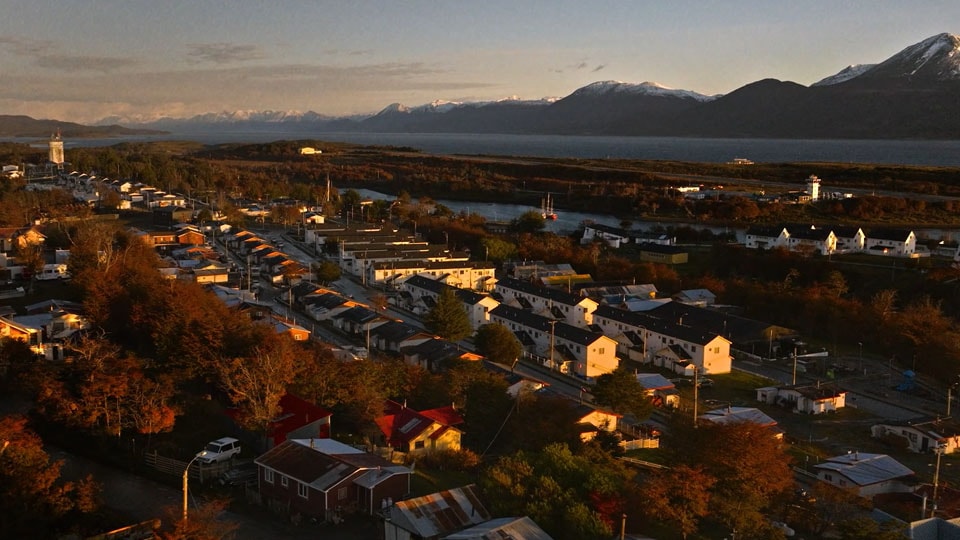Chile’s Puerto Williams: world southernmost town now has 5G
(Posted August 2023) Gabriel , a young nurse in his 20s, recalls what his childhood was like when his family moved when he was 3 to Puerto Williams, a small Chilean town at the southern tip of the American continent that is the world’s southernmost city. “We lived offline,” he says. “It was a disconnected childhood.” The area is off the mainland on the island of Isla Navarina, with several other islands nearby.
With a population of 2,800, Puerto Williams is a quiet little coastal community where one of the main industries is fishing. A spectacular range of snowcapped mountains that towers above the city prevents road access from the outside. Painfully beautiful as it is, Puerto Williams is pretty much the end of the world, the middle of nowhere.

Puerto Williams is surrounded by stark beauty
Being cut off from the digital world and the often-unwanted distractions it brings may sound appealing to some. But it definitely has its downsides. It’s challenging to keep up with news from the outside world, for doctors to access resources from the big city, or for fishermen to market their catch.
Change recently came to the community. In 2019, a submarine optical fiber was extended to the fishing port to provide a backbone connection to the rest of the world. The cable needed to be routed under the sea because of the mountain range and glaciers that cut off Navarina from the rest of Chile.

Glaciers are one of the obstacles between Puerto Williams and other parts of Chile
With the cable connection, it wasn’t long before people got full connectivity all over town. Chilean carrier Movistar and Huawei teamed up to deploy 4G coverage shortly after. The town’s hilly geography came in handy because it allowed the placement of towers higher above ground, further extending coverage to the fishing boats at sea.

The world’s southernmost town now has 4G and 5G coverage
Williams Solís, Gabriel’s father, witnessed the development of telecommunications in the small town first-hand over the past 20 years. A telecom engineer, he was first sent to Puerto Williams in the early 2000s to maintain the city’s then rudimentary telecom infrastructure. “Send Williams to Puerto Williams,” he overheard his supervisor quip back then.
Puerto Williams was like finding a calling for the elder Solís. “I never thought about the importance that I had here,” he says. “I help maintain people's communication with the rest of the world.”

Williams and Gabriel Solís at home
Now that Puerto Williams has 4G coverage, local internet suppliers decided to go one step further with 5G. In fact, it’s the very isolation of the town that makes this decision logical.
At local hospital, Cristina Calderón, connectivity is fundamental for digitalizing patient’s medical records. This digitization allows accessing resources from bigger hospitals far away. Derek Gützlaff, a doctor at the medical center, says that otherwise, the only way to get more sophisticated health care and access to specialists is to travel by plane to Punta Arenas, a town 550 kilometers away, at the continent. With 5G, specialists can help with diagnosis and treatment protocols through videoconferencing and instantaneous sharing of digital information about patients.
"When we take an X-ray and we need a specialist to see it, it's done online. For that person who arrives at the emergency room, time is limited to do something, every second counts,” says Gützlaff. “One associates having a good cell phone or a fast internet connection with a luxury, but it is no longer a luxury, it is something that can save someone's life."

Connectivity enables easier sharing of medical data with specialists in the city
Gabriel Solís is now a nurse at the hospital. He recalls that all the changes are a far cry from his first memories of Puerto Williams. “We arrived and a couple of months passed and for me it was very cold,” he recalls. “I have memories that everything was dirt and everything was scarce.”
The fishery industry is also expected to benefit from the deployment of 5G networks. It enables access to more sophisticated and accurate micro weather forecasts. Sea conditions off Puerto Williams are often very specific to the area because they are affected by the area’s many islands as well as the mountain range. Historically, fishermen set out without really knowing what was awaiting them offshore.

Fishermen are connected, at sea or on land
In town, shops will also benefit from 5G coverage. At the town’s largest store, Simon & Simon, co-owner Simon recalls how he founded the business with his father in the 1990s with three boxes of bananas.
It was hard to connect with suppliers, he recalls, something that has completely changed in recent years.
“We have everything connected, like the checkout system,” Simon says. “We have cameras connected to the system. So, if you -for example- want to check a price, you need to verify something, the connectivity will improve the customer service.”
In recent years, Chile has become a leader in digital connectivity in Latin America and the Caribbean, including 5G deployment. The country has ambitious targets to provide 5G coverage in all urban areas nationwide by 2025, up from an already-impressive 50% now. The success story that is Puerto Williams will replicate itself nationwide.
Watch the video to see how 5G is changing Puerto Williams.

